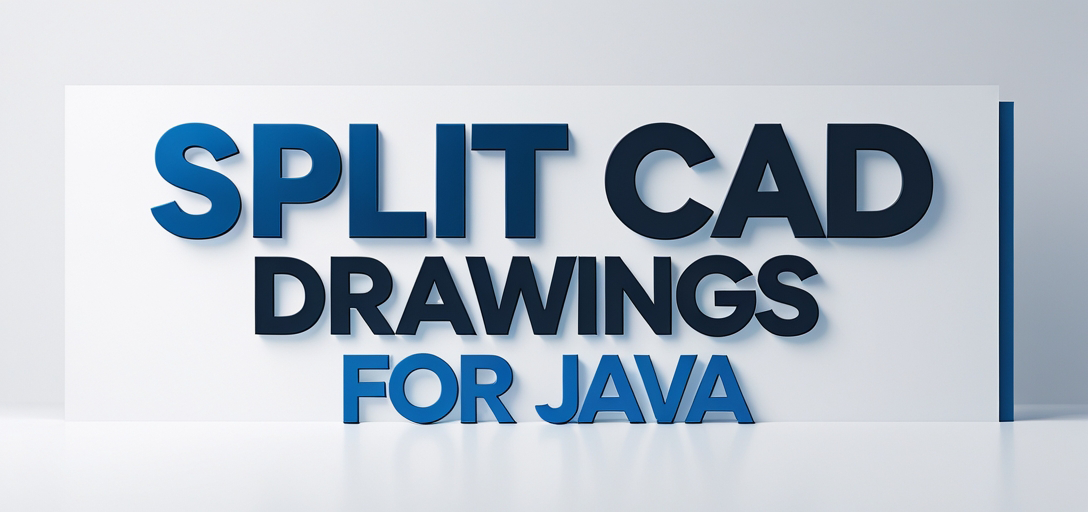Split CAD Drawings into Tiles with GroupDocs.Viewer Java
Introduction
Struggling to manage and render large CAD drawings efficiently in your Java application? This guide will demonstrate how to use GroupDocs.Viewer for Java to split these drawings into manageable tiles. By dividing the drawing into smaller sections, you can significantly enhance performance and ease of handling.

What You’ll Learn:
- Setting up and configuring GroupDocs.Viewer for Java.
- A step-by-step process to split CAD drawings into tiles.
- Key configurations and optimization techniques.
- Practical applications and integration possibilities.
Let’s start by ensuring your environment is ready with the necessary prerequisites.
Prerequisites
Before we begin, ensure you have:
- Libraries: GroupDocs.Viewer for Java (version 25.2 or later).
- Environment Setup: A working Java Development Kit (JDK) and an integrated development environment like IntelliJ IDEA or Eclipse.
- Knowledge Prerequisites: Basic understanding of Java programming and familiarity with the Maven build tool.
Setting Up GroupDocs.Viewer for Java
To use GroupDocs.Viewer, add it as a dependency in your project. If you’re using Maven:
Maven Configuration:
<repositories>
<repository>
<id>repository.groupdocs.com</id>
<name>GroupDocs Repository</name>
<url>https://releases.groupdocs.com/viewer/java/</url>
</repository>
</repositories>
<dependencies>
<dependency>
<groupId>com.groupdocs</groupId>
<artifactId>groupdocs-viewer</artifactId>
<version>25.2</version>
</dependency>
</dependencies>
License Acquisition
GroupDocs.Viewer offers a free trial license to explore its full capabilities:
- Free Trial: Visit GroupDocs Free Trial to download and test the library.
- Temporary License: Apply for a temporary license at Temporary License Page.
- Purchase: Purchase a full license on their Purchase Page.
Basic Initialization and Setup
To initialize GroupDocs.Viewer in your Java application:
import com.groupdocs.viewer.Viewer;
public class ViewerSetup {
public static void main(String[] args) {
try (Viewer viewer = new Viewer("path/to/your/drawing.dwg")) {
// Your rendering code goes here.
}
}
}
With the setup complete, let’s proceed to implement the feature.
Implementation Guide
Split Drawing into Tiles
This section demonstrates how to split a CAD drawing into smaller tiles for more efficient handling and rendering. Each tile will be a quarter of the original size.
Step 1: Define Output Directory Path
Start by defining where your rendered images will be saved:
import java.nio.file.Path;
Path outputDirectory = Utils.getOutputDirectoryPath("SplitDrawingIntoTiles");
Path pageFilePathFormat = outputDirectory.resolve("page_{0}.png");
This setup uses a utility method to get the path, ensuring reusability and clarity.
Step 2: Configure View Options
Set up options for rendering each section separately:
import com.groupdocs.viewer.options.PngViewOptions;
import com.groupdocs.viewer.options.ViewInfoOptions;
PngViewOptions viewOptions = new PngViewOptions(pageFilePathFormat);
ViewInfoOptions viewInfoOptions = ViewInfoOptions.forPngView(false);
This code snippet configures the rendering to PNG format without processing all pages at once.
Step 3: Calculate Tile Dimensions
Determine the dimensions for each tile:
import com.groupdocs.viewer.results.ViewInfo;
import com.groupdocs.viewer.options.Tile;
ViewInfo viewInfo = new Viewer("path/to/your/drawing.dwg").getViewer().getViewInfo(viewInfoOptions);
int width = viewInfo.getPages().get(0).getWidth();
int height = viewInfo.getPages().get(0).getHeight();
// Each tile is a quarter of the total size.
int tileWidth = width / 2;
int tileHeight = height / 2;
Tile[] tiles = {
new Tile(0, 0, tileWidth, tileHeight),
new Tile(tileWidth, 0, tileWidth, tileHeight),
new Tile(0, tileHeight, tileWidth, tileHeight),
new Tile(tileWidth, tileHeight, tileWidth, tileHeight)
};
Step 4: Render and Save Tiles
Add each calculated tile to the rendering options and render:
viewOptions.getCadOptions().getTiles().addAll(java.util.Arrays.asList(tiles));
try (Viewer viewer = new Viewer("path/to/your/drawing.dwg")) {
viewer.view(viewOptions);
}
This final step renders the document based on the specified tiles, saving each as a separate PNG file.
Troubleshooting Tips
- Ensure your project’s build path includes GroupDocs.Viewer JAR files.
- Verify that the output directory is writable by your application.
- Check for any exceptions in rendering to diagnose issues with specific drawing files.
Practical Applications
Splitting CAD drawings into tiles can be beneficial in:
- Web Mapping: Efficiently loading large architectural plans on web maps without overloading server resources.
- Document Management Systems: Easier management and quicker access to specific sections of large drawings.
- Mobile Apps: Enhancing performance by rendering only necessary parts of a drawing based on user interaction.
Performance Considerations
To optimize your application’s performance:
- Use tiles strategically to balance between detail and processing time.
- Monitor memory usage, especially when dealing with very large drawings.
- Employ best practices in Java for efficient memory management, such as using try-with-resources for automatic resource cleanup.
Conclusion
You’ve now learned how to split CAD drawings into tiles using GroupDocs.Viewer for Java. This approach not only improves rendering performance but also enhances the usability of your application when dealing with large document files.
Next Steps:
- Experiment with different tile sizes based on specific use cases.
- Explore other features offered by GroupDocs.Viewer to further enhance your document processing capabilities.
Ready to implement this solution in your project? Try it out and see the improvements for yourself!
FAQ Section
- What are some common errors when using GroupDocs.Viewer Java?
- Common issues include incorrect file paths, insufficient permissions on output directories, or missing dependencies.
- Can I split other types of documents into tiles with this method?
- While the example focuses on CAD drawings, similar principles can be applied to other document formats supported by GroupDocs.Viewer.
- How do I handle larger files efficiently?
- Consider using multi-threading or async processing in Java to manage large file rendering.
- Is there support for customizing output image quality?
- Yes, you can adjust the PNGViewOptions settings to change the resolution and quality of rendered images.
- What should I do if my application runs out of memory during rendering?
- Optimize your tile sizes and consider increasing Java’s heap size with VM options like
-Xmxfor more available memory.
- Optimize your tile sizes and consider increasing Java’s heap size with VM options like
Resources
- Documentation
- API Reference
- Download GroupDocs.Viewer
- Purchase a License
- Free Trial
- Temporary License
- Support Forum
By following this guide, you’re well-equipped to implement efficient document rendering in your Java applications using GroupDocs.Viewer. Happy coding!